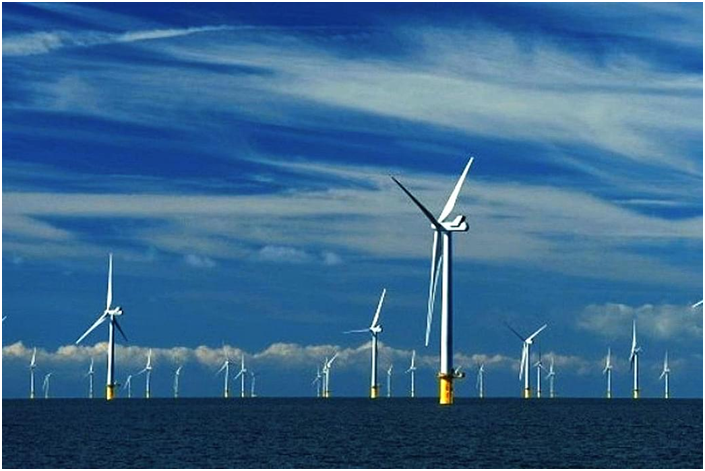PLI scheme for the offshore wind industry (GS Paper 3, Economy)

Why in news?
- In 2021, India initiated a production-linked incentive (PLI) program of Rs 420 billion (US$5.3 billion) to manufacture solar modules and batteries for electric vehicles and energy storage.
- Now, the government plans to formulate a PLI scheme to augment the offshore wind industry as well in the country. Such a scheme would provide direct subsidies to manufacturers interested in building facilities in India to make offshore wind power turbines.
India’s energy transition:
- India’s energy transition presents a larger opportunity than just reducing carbon emissions.
- India’s long-term targets of decarbonising its power, transport and other hard-to-abate sectors need billions of dollars of investments in clean energy infrastructure.
- The government has been trying to reduce its import dependence for clean energy technologies by incentivising domestic development and manufacturing. Maturing domestic value chains for clean energy will create additional jobs and attract more investments.
Potential in offshore wind:
- The government recognises a huge potential in offshore wind. India has set an ambitious target of installing 30 gigawatts (GW) of offshore wind capacity by 2030.
- India came up with its offshore wind power policy in 2015, but no projects have taken off since then, primarily because it costs significantly higher than solar and onshore wind.
- Despite the higher costs today, offshore wind is an important resource for decarbonising India’s power sector.
- India has the potential to generate 140GW of electricity from offshore wind along its 7,600km coastline. Half of this potential is near the coasts of Tamil Nadu and Gujarat.
India’s offshore wind power plans:
- The Ministry of new and renewable energy recently revived India’s offshore wind power plans with an announcement of a mega 4GW tender for offshore wind power off the coasts of Tamil Nadu and Gujarat in the next few months.
- The announcement came during MNRE’s recent meeting with the Central Transmission Utility (CTU) on network planning for offshore wind, a challenging aspect of its development.
- Offshore wind could deliver utilisation factors of more than 50-55% with a better wind resource profile in deep oceans. These are materially higher than its onshore counterpart that can reach up to 30-35%.
- Further, India’s wind generation profile, peaking between evening and early morning hours, is complementary to solar, peaking during the afternoon.
- Therefore, adding offshore wind to the generation mix would potentially provide India with a better round-the-clock clean power resource and add resource diversification benefits.
Challenges:
- One of the key requirements to unlock the potential for offshore wind in India is to develop the local supply chain, logistics and port infrastructure.
- A report on analyses of various aspects of the value chain in Tamil Nadu and Gujarat suggests the development of special coastal facilities to build wind turbine assemblies that would require investments to the tune of billions of rupees. Investment on this scale needs visibility of substantial market size and a strong order book for prospective Original Equipment Manufacturers (OEMs).
- Port infrastructure, too, will require specialised upgrades to handle large equipment.
- The offshore wind turbines historically have been versions of onshore turbines adapted for the marine environment. However, over the past decade, the technology of offshore turbines has grown immensely.
- Offshore wind turbines are much larger and focus more on reliability and durability in the hostile environment of deep oceans.
PLI scheme:
- Currently, India has a substantial base for manufacturing onshore wind turbines but not for its offshore counterpart. Some European OEMs (Siemens, Vestas, Alstom) and Chinese OEMs (Goldwind, Ming and XEMC) have the best-in-class wind turbine technologies.
- The PLI scheme could attract some top global OEMs to start manufacturing turbines in India.
- The recently announced auctions to commission offshore wind generation capacity need to materialise to create visibility of a project pipeline. This would provide a strong signal for the OEMs to invest the required billions of rupees in turbine manufacturing in India.
Blue bonds:
- A new class of financial instruments, blue bonds have emerged. Blue bonds focus on supporting marine-related projects, such as protecting ocean life, reducing pollution and building offshore wind farms.
- In 2020, Bank of China issued Asia’s first blue bond worth $942 million for projects supporting clean oceans.
- Technology advancements and innovative financing have driven the cost-deflation in clean energy technologies over the past decade. A similar story could unfold for India’s offshore wind industry if policymakers show sincere commitment to developing the industry.
Way Forward:
- The interest in offshore wind is increasing globally, especially in the Asia Pacific region. China installed 16.9GW of offshore capacity in 2021, equal to 30% of the 57.1GW worldwide operational capacity.
- Australia, Japan, Taiwan and Vietnam have been late to tap offshore wind power but now have strong ambitions to exploit this valuable clean energy resource.
India, too, would benefit from strongly pursuing the offshore wind dream.


